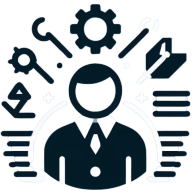9 Training Techniques for Teaching Complex Operational Procedures
Mastering complex operational procedures is a challenge that many organizations face in today's fast-paced business environment. This article explores innovative 9 training techniques that promise to revolutionize the way companies teach and implement intricate processes. Drawing from the insights of industry experts, these methods combine cutting-edge technology with proven pedagogical approaches to enhance learning outcomes and operational efficiency.
- Combine Visual SOPs with Live Shadowing
- Create Mini Playbooks Through Active Learning
- Implement Scenario-Based Microlearning with Interactive SOPs
- Build Interactive Decision Trees in Notion
- Use Shadow-to-Simulation Model for Complex Fields
- Blend Hands-On Learning with Self-Paced Modules
- Record Screen Walkthroughs with Follow-Up Quizzes
- Develop Failure-Based Scenarios for Real-World Learning
- Employ Digital Shadow Approach with AR
Combine Visual SOPs with Live Shadowing
The most effective way I've found to train new employees is by combining step-by-step visual SOPs with live shadowing sessions. At BASSAM, we deal with detailed logistics workflows where small mistakes can have serious consequences. So clarity and hands-on understanding are essential.
We created a set of illustrated process guides that break down each task into clear steps, supported by real screenshots and examples from our systems. But we don't stop there. I always pair new team members with experienced staff for the first few days, so they can observe actual workflows, ask questions in real-time, and understand the "why" behind each action.
One tool that has helped us a lot is Loom. We use it to record short walkthrough videos of repetitive tasks. New hires can refer back to these anytime without having to wait for someone to explain again. It speeds up learning and reduces mistakes.
In operations, repetition builds confidence. But clarity builds trust, and both are necessary for smooth handovers and long-term efficiency.

Create Mini Playbooks Through Active Learning
The most effective method I've used for training new employees on complex procedures is pairing them with a "shadow buddy" during their first two weeks, but with a twist. Instead of just observing, the new hire was responsible for creating a mini playbook of the procedure they were learning. I recall doing this with a new operations analyst who was onboarding into our vendor reconciliation process—a task that requires a lot of nuance. By the end of week two, not only had she internalized the steps, but she had also identified gaps and outdated assumptions in our current documentation.
That one exercise did more than just accelerate her learning—it gave her a sense of ownership from the very beginning. It also left us with a cleaner, updated SOP we could use for the next hire. The key was shifting the learning mode from passive to active, and turning documentation into a living, peer-reviewed tool. If you want your team to retain what they're taught, give them a reason to teach it back. That's where the absolute clarity happens.

Implement Scenario-Based Microlearning with Interactive SOPs
Training new employees on complex operational procedures used to feel like trying to teach someone to swim over a Zoom call—lots of words, little retention. The real game-changer for us was introducing scenario-based microlearning, layered with interactive SOPs that employees could access on demand. Instead of overwhelming new hires with a thick binder or a marathon training day, we broke procedures down into bite-sized, real-world scenarios they'd actually encounter in the role.
Let's say someone's learning a multi-step inventory reconciliation process. Instead of handing over a generic checklist, we walk them through a simulated issue—maybe a miscounted SKU or a supplier delay—and have them troubleshoot within that sandbox. We use tools like Loom and Notion to combine short walkthrough videos, clickable SOPs, and real-time assessments, so they're learning by doing, not just watching. It's part training, part puzzle—and that interactivity boosts engagement and retention.
But the most powerful part is that it doesn't stop on day one. We embed "operational nudges" into their workflow using tools like Slack or Trello—quick reminders, links to SOPs, or even short videos that pop up when they're about to perform a task. It keeps learning contextual and alive, instead of locked away in a forgotten training folder.
The feedback from new hires? Overwhelmingly positive. They feel less intimidated by complex systems and more empowered to take initiative early. And from a leadership perspective, we've seen error rates drop, ramp-up time shorten, and overall team confidence rise.
Training isn't about dumping knowledge—it's about delivering it in the right moment, in the right format, with just enough friction to make it stick. And when you get that balance right, the payoff is huge—not just in efficiency, but in culture.
Build Interactive Decision Trees in Notion
The best method we've landed on is building interactive, scenario-based Notion pages for training. Instead of a long manual or a static SOP doc, we create guided decision trees that walk new hires through real-life situations they'll face—like how to handle a delayed client deliverable or a scope change mid-project. It started when one of our ops hires kept getting tripped up not by the steps, but by the exceptions. So we built a training path where each choice they make reveals the next likely scenario, including links to the tools or templates they'd use.
What made it click was how it mimicked live problem-solving without requiring someone to hover over their shoulder. That hire ramped up in record time, and now it's part of our standard onboarding. The tip I'd offer: train for decision-making, not just process. It's easy to teach someone which button to press—it's harder, but more valuable, to help them know why they're pressing it in the first place.

Use Shadow-to-Simulation Model for Complex Fields
The most effective training method we've implemented at Ridgeline Recovery is a shadow-to-simulation model. Addiction treatment work is layered—clinical compliance, emotional sensitivity, real-time decision-making—and new staff can get overwhelmed fast.
We start by pairing new hires with seasoned team members during real interactions—not just observation, but full shadowing with hands-on responsibilities in stages. After that, we move them into scenario-based simulations using actual case studies pulled from anonymized records. This gives them a safe space to practice critical judgment under pressure—exactly what's required in our field.
One example: A new case manager struggled with treatment plan documentation. After shadowing, we ran her through a roleplay simulating a client relapse scenario. She received direct, real-time feedback, and by the end of week two, her documentation and communication were both significantly sharper.
Complex operations need muscle memory and instinct. This model builds both—without putting patients or staff at risk.
Blend Hands-On Learning with Self-Paced Modules
The most effective way I've found to train new employees on complex operational procedures is through a combination of hands-on learning and bite-sized, self-paced modules. When I onboard new hires, I break down complex processes into smaller steps and use interactive training software like Trainual to guide them through each part. This platform allows me to create step-by-step guides, videos, and quizzes to reinforce learning. For example, when training a new employee on our customer service process, I first had them watch a video explaining the steps, then gave them a chance to practice in a sandbox environment. Afterward, they completed a quiz to ensure they understood the material. This combination of self-paced learning and practical application has helped my new hires retain information more effectively and feel confident applying it in real-world scenarios.

Record Screen Walkthroughs with Follow-Up Quizzes
The most effective approach I've found is using screen recording walkthroughs paired with a quick quiz at the end. When we hired our first ops assistant, I tried the usual live shadowing and written documentation, but it didn't stick. There were too many steps and too many exceptions. So I started recording myself doing each task—whether it was submitting invoices or managing a software subscription—with Loom. Then, I added a short recap quiz using Google Forms to ensure key points were understood.
What surprised me was how much faster onboarding went. The new hire could rewatch the videos at their own pace, pause where needed, and return with more informed questions. It also freed up my time from repeating the same demonstrations. My advice: build a mini video library of your core workflows and let it do the heavy lifting. It's like cloning your best trainer without taking them away from their actual work.
Develop Failure-Based Scenarios for Real-World Learning
One of the best training tools we've built at Rowland is what we call "failure-based scenarios." Instead of just showing new hires how a perfect job should go, we walk them through examples of what happens when a job doesn't go right—missed prep, incorrect application, bad documentation. We use actual case studies from past callbacks (with names and addresses stripped out, of course) and have them problem-solve what went wrong. It's not about shaming anyone—it's about teaching real-world consequences in a low-stakes setting.
I remember walking one new technician through a scenario where the customer kept seeing ants after service. He traced the whole thing back to a missed entry point that wasn't documented. That clicked for him in a way that a checklist never would have. On his following route, he took extra time to inspect and document—no callbacks. That kind of learning sticks because it's tied to real pressure and real outcomes. If you're training for precision and accountability, demonstrating what not to do can sometimes be more effective than showing what to do.
Employ Digital Shadow Approach with AR
I've found that blending hands-on simulation with digital tools creates the most effective training environment for complex operational procedures. When I started Fulfill.com, we faced the challenge of training team members on intricate 3PL workflows that differed across client accounts.
Our breakthrough came when we implemented what I call the "Digital Shadow" approach. We pair new hires with experienced team members, but instead of traditional shadowing, they document each process in real-time using digital tools like Loom for video capture and collaborative SOPs. This transforms passive observation into active learning while building our knowledge base.
The real game-changer was introducing microlearning modules focused on scenario-based challenges. Rather than overwhelming new employees with comprehensive manuals, we break down complex procedures into digestible segments that simulate real client situations they'll encounter. Each module includes decision points that provide immediate feedback, allowing them to learn from mistakes in a risk-free environment.
We've also leveraged AR technology for warehouse training—creating a virtual overlay that highlights picking paths and SKU locations. This reduced our fulfillment error rates by 34% in the first quarter after implementation.
What's fascinating is how this approach accommodates different learning styles. Visual learners thrive with the AR component, while hands-on employees excel in the simulation exercises. The digital documentation benefits those who learn by teaching others.
The ROI has been substantial—our onboarding time decreased by 40%, and new employees reach productivity benchmarks three weeks faster than with traditional training methods. More importantly, they retain the knowledge because they've applied it in context rather than memorizing procedures in isolation.
In the fast-evolving 3PL space, this blend of technology and experiential learning creates adaptable problem-solvers rather than process followers.






